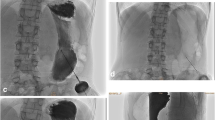Abstract
Background
The introducer method of percutaneous endoscopic gastrostomy (PEG) minimizes procedure-related peristomal infection. Ultrathin transnasal endoscopy (UTE) allows comfortable endoscopic examination of patients with fewer adverse effects and passage of the endoscope through a narrow esophagus or oropharynx. This study aimed to investigate the clinical outcomes for the introducer method of PEG with UTE.
Methods
Patients who underwent the introducer method of PEG with UTE between March 2009 and May 2012 were analyzed. The outcomes and complications of the patients within 180 days after gastrostomy placement were investigated.
Result
During the study period, 92 patients (31.9 % male; age, 67.7 ± 16.6 years) underwent the introducer method of PEG with UTE. The major indications for PEG insertion were stroke (40.4 %), esophageal cancer or head and neck cancer (27.1 %), and neurologic disorder (14.9 %). Esophageal stenosis was identified by endoscopy or imaging in 14 patients before PEG. In all the patients, UTE was successfully introduced through the nasal cavity. In 90 (97.8 %) of the 92 patients, PEG was successfully inserted. Insertion of the endoscope into the stomach was impossible in two patients because head and neck cancer caused severe narrowing of the upper esophagus. No procedure-related peristomal infection, gastric contents leakage, or bleeding occurred within 30 days after gastrostomy placement. In eight patients (8.7 %), catheter displacement occurred within 30 days. Catheter displacement in 44 patients (47.8 %) and gastric contents leakage in eight patients (9 %) occurred within 30–180 days after gastrostomy placement.
Conclusion
Introducer PEG with UTE is a useful method for gastrostomy placement with a high success rate. This technique allows procedure-related complications to be avoided and permits the use of endoscopy in patients with narrow esophagi or oropharynges. However, the long-term durability of the balloon-type catheter is questionable.
Similar content being viewed by others
References
Gauderer MW, Ponsky JL, Izant RJ Jr (1980) Gastrostomy without laparotomy: a percutaneous endoscopic technique. J Pediatr Surg 15:872–875
Richards DM, Tanikella R, Arora G, Guha S, Dekovich AA (2012) Percutaneous endoscopic gastrostomy in cancer patients: predictors of 30-day complications, 30-day mortality, and overall mortality. Dig Dis Sci 58(3):768–776
Schapiro GD, Edmundowicz SA (1996) Complications of percutaneous endoscopic gastrostomy. Gastrointest Endosc Clin North Am 6:409–422
Dormann AJ, Wejda B, Kahl S, Huchzermeyer H, Ebert MP, Malfertheiner P (2006) Long-term results with a new introducer method with gastropexy for percutaneous endoscopic gastrostomy. Am J Gastroenterol 101:1229–1234
Yuki M, Amano Y, Komazawa Y, Fukuhara H, Shizuku T, Yamamoto S, Kinoshita Y (2009) Unsedated transnasal small-caliber esophagogastroduodenoscopy in elderly and bedridden patients. World J Gastroenterol 15:5586–5591
Quine MA, Bell GD, McCloy RF, Charlton JE, Devlin HB, Hopkins A (1995) Prospective audit of upper gastrointestinal endoscopy in two regions of England: safety, staffing, and sedation methods. Gut 36:462–467
Dumortier J, Lapalus MG, Pereira A, Lagarrigue JP, Chavaillon A, Ponchon T (2004) Unsedated transnasal peg placement. Gastrointest Endosc 59:54–57
Vitale MA, Villotti G, D’Alba L, De Cesare MA, Frontespezi S, Iacopini G (2005) Unsedated transnasal percutaneous endoscopic gastrostomy placement in selected patients. Endoscopy 37:48–51
Taller A, Horvath E, Ilias L, Kotai Z, Simig M, Elo J, Harsanyi L (2001) Technical modifications for improving the success rate of peg tube placement in patients with head and neck cancer. Gastrointest Endosc 54:633–636
Aydinli M, Koruk I, Dag MS, Savas MC, Kadayifci A (2012) Ultrathin endoscopy for gastrointestinal strictures. Dig Endosc 24:150–153
Maetani I, Tada T, Ukita T, Inoue H, Sakai Y, Yoshikawa M (2003) Peg with introducer or pull method: a prospective randomized comparison. Gastrointest Endosc 57:837–841
Shastri YM, Hoepffner N, Tessmer A, Ackermann H, Schroeder O, Stein J (2008) New introducer peg gastropexy does not require prophylactic antibiotics: multicenter prospective randomized double-blind placebo-controlled study. Gastrointest Endosc 67:620–628
Lim C, Park JM, Cho YK, Lee IS, Kim SW, Choi M, Chung I (2011) Successful control of peristomal infection by introducer-type percutaneous endoscopic gastrostomy: a retrospective historical control study. Dig Dis Sci 56:2024–2029
Lustberg AM, Darwin PE (2002) A pilot study of transnasal percutaneous endoscopic gastrostomy. Am J Gastroenterol 97:1273–1274
Deitel M, Bendago M, Spratt EH, Burul CJ, To TB (1988) Percutaneous endoscopic gastrostomy by the “pull” and “introducer” methods. Can J Surg 31:102–104
Acknowledgments
This study was supported by Business of Globalization for Science and Technology funded by the Ministry of Education, Science and Technology, Seoul, Republic of Korea (Grant NRF-2011-0031644).
Disclosures
Hong Seok Lee, Chul-Hyun Lim, Eun Young Park, Wook-Hyun Lee, Jinhee No, Byoung Yeon Jun, Sung Jin Moon, Jin Su Kim, Yu Kyung Cho, Jae Myung Park, In Seok Lee, Sang Woo Kim, Myung-Gyu Choi and Kyu Yong Choi have no conflicts of interest or financial ties to disclose.
Author information
Authors and Affiliations
Corresponding author
Rights and permissions
About this article
Cite this article
Lee, H.S., Lim, CH., Park, E.Y. et al. Usefulness of the introducer method for percutaneous endoscopic gastrostomy using ultrathin transnasal endoscopy. Surg Endosc 28, 603–606 (2014). https://doi.org/10.1007/s00464-013-3215-x
Received:
Accepted:
Published:
Issue Date:
DOI: https://doi.org/10.1007/s00464-013-3215-x



